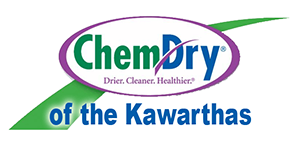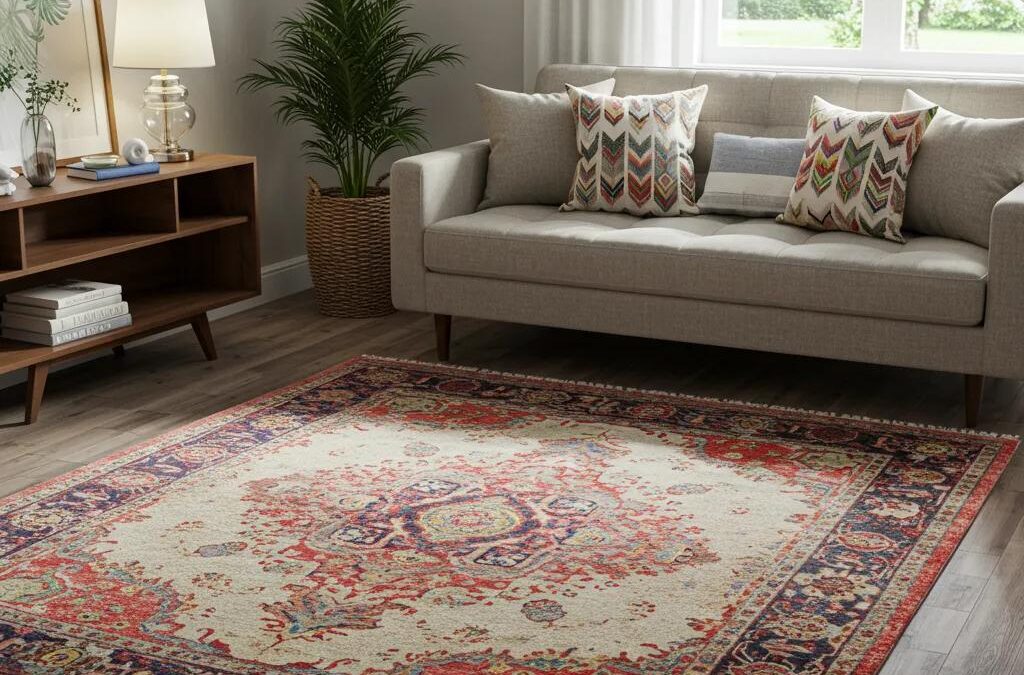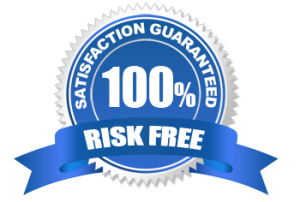Keeping your area rugs clean and well-maintained is key to a healthier home, longer-lasting fibers, and protecting your valuable floor coverings. Over time, rugs can trap dirt, allergens, and moisture, which not only wears them down but can also impact your well-being. This guide will uncover the hidden issues in neglected rugs, explain how professional cleaning revitalizes them, compare DIY methods with Chem-Dry Kawarthas superior hot carbonating extraction, help you determine the best cleaning schedule, share practical upkeep tips, tackle pet stains effectively, and provide specific advice for wool, silk, synthetic, and treasured rugs. By understanding how to care for your area rugs and utilizing expert services, you can ensure a fresher, more attractive living space while safeguarding your investment.
What Are the Hidden Dangers Lurking in Neglected Area Rugs?
Untreated area rugs can become a breeding ground for embedded dirt, moisture, and microorganisms that degrade fibers, harm indoor air quality, and pose health risks. Tiny abrasive particles can cut into the rug’s weaves, while dampness can lead to mildew and unpleasant smells. Recognizing these dangers will help you prioritize rug cleaning to maintain both its appearance and your home’s health. The following sections delve into the specific ways unmaintained rugs can suffer and impact your well-being.
How Do Dirt, Dust, and Gritty Particles Harm Your Area Rug?
Dirt and dust are made up of fine particles that act like sandpaper on your rug fibers with every footstep, causing thinning, fuzzing, and permanent wear. As debris builds up in the pile, each step pushes abrasive fragments deeper, breaking down individual fibers and making the rug feel less soft. For instance, sand tracked in from outside can act like tiny cutting tools, eroding wool or synthetic strands.
Microscopic studies showing before-and-after comparisons reveal how embedded grit increases friction and fiber breakage, speeding up matting and discoloration. Understanding this mechanical wear emphasizes the importance of regular vacuuming and professional deep cleaning to remove trapped particles and preserve the rug’s fibers.
Why Do Allergens in Area Rugs Impact Your Home’s Air Quality and Health?
Allergens like dust mites, pet dander, and pollen get trapped in rug fibers, accumulating and releasing airborne particles that can worsen respiratory problems. These microscopic irritants can trigger allergic reactions and asthma symptoms by lodging in your nasal passages and lungs. For example, homes with unclean rugs often have higher concentrations of dust mites, leading to more frequent allergy flare-ups for sensitive individuals.
Reducing the allergen load through professional cleaning methods that effectively remove deeply embedded particles contributes to healthier indoor air and lowers the risk of chronic respiratory issues. Addressing this hidden source of pollutants helps protect your family’s well-being and supports a healthy home environment.
What Causes Unpleasant Smells and Mildew in Area Rugs?
Moisture from spills, high humidity, or residue from cleaning can create the perfect conditions for mold and mildew to grow beneath the rug’s backing, leading to musty odors and visible stains. Pet urine and food spills can worsen odors by introducing organic matter that bacteria break down, releasing sour or ammonia-like smells. For example, even a small amount of dampness under a rug pad can encourage mold spores that emit persistent damp odors.
Eliminating this moisture through low-moisture, fast-drying cleaning processes and prompt stain treatment prevents mildew and odor buildup. Keeping surfaces dry and clean stops microbial growth and ensures your rugs smell fresh.
How Does Professional Area Rug Cleaning Protect Your Investment?

Professional area rug cleaning removes deeply embedded contaminants, restores the resilience of rug fibers, and extends the overall lifespan of your rug by addressing damage that DIY methods often can’t fully resolve. Expert technicians assess the material type, soil levels, and structural condition to apply specialized cleaning processes that revitalize both appearance and hygiene. Investing in periodic professional service helps you avoid costly premature replacement and maintain your rug’s value.
How Does Professional Cleaning Extend the Life of Your Area Rug?
Professional cleaning prevents fiber abrasion and breakdown by extracting trapped grit and particulate matter that accelerate wear. Techniques like high-efficiency agitation and low-moisture extraction lift soils without oversaturating fibers, preserving the weave’s strength and flexibility. A well-maintained rug can retain up to 80 percent of its original integrity compared to untreated rugs, maximizing its years of use.
By removing abrasive debris and reinforcing the fiber structure, professional services offer tangible benefits for longevity that justify regular maintenance schedules.
Why Is It Important to Maintain Vibrant Colors and Softness?
Accumulated soils and mineral deposits can dull the vibrancy of dyes and make fibers feel stiff, making rugs look lifeless and feel rough underfoot. Professional cleaning revitalizes color by removing light-blocking grime and smoothing pile strands, restoring the original softness and clarity of patterns. For instance, removing acidic pet stains can revive wool’s natural luster and maintain dye stability.
Preserving vibrant hues and a plush texture keeps rugs visually appealing, enhancing your decor and contributing to a sense of home elegance.
How Does a Clean Rug Enhance Your Home’s Aesthetic Appeal?
A freshly cleaned area rug acts as a decorative centerpiece, showcasing patterns and colors that elevate your interior design. Clean edges and even pile height reflect attention to detail and create a welcoming atmosphere. In contrast, a soiled rug can detract from furniture and wall treatments, making rooms feel neglected.
By ensuring your rugs look their best, you reinforce overall style cohesion, boost your home’s appeal, and create inviting spaces for guests and family.
What Are the Key Differences Between DIY and Professional Rug Cleaning Methods?
Understanding how to maintain your area rugs begins with recognizing that DIY approaches often use generic equipment and solutions that leave residues, fail to extract deep soils, and risk over-wetting fibers. Professional rug cleaning utilizes advanced hot carbonating extraction and eco-friendly products to deliver healthier, faster-drying results with minimal chemical use. The table below compares the core attributes of both approaches.
| Method | Equipment Used | Cleaning Effectiveness |
|---|---|---|
| DIY Rental Machines | Standard carpet steamer, limited suction | Surface cleaning with potential residue |
| Household Spot Cleaners | Store-bought detergents, towels | Inconsistent stain removal, fiber distortion |
| Professional Service | Hot carbonating extraction, industrial vacuums | Deep extraction of soils and allergens |
Professional techniques are more effective at extracting embedded contaminants without oversaturating fibers, preserving rug integrity and ensuring thorough allergen removal. Comparing these methods highlights why homeowners seeking the best results often turn to expert services.
Research indicates that professional carpet cleaning, which includes area rugs, involves specific maintenance expenditures and costs that differ from DIY methods.
Residential Flooring: Installation and Maintenance Expenditures… derived from maintenance frequencies and the types of maintenance materials utilized as reported by homemakers, alongside maintenance costs… and the expense of professional carpet cleaning is presented…Flooring costs: a comparison of installation and maintenance costs for three types of residential flooring
What Are the Limitations and Risks of DIY Rug Cleaning?
DIY cleaning can leave behind detergent residues that attract new dirt, over-wet fibers that can lead to mold, and apply excessive mechanical agitation that frays delicate weaves. Inadequate drying times increase the risk of mildew, while generic equipment cannot reach soils deep in the pile. For example, using a rotary brush on an Oriental rug might distort its intricate knots.
Recognizing these potential pitfalls underscores the value of trained technicians who tailor their methods to the rug’s composition and soil conditions.
How Does Chem-Dry Kawarthas Hot Carbonating Extraction (HCE) Process Provide a Healthier, Drier Clean?
Chem-Dry Kawarthas HCE process uses millions of microscopic carbonating bubbles to lift dirt and allergens to the surface for removal by powerful suction, using 80 percent less water than traditional steam cleaning. This low-moisture approach significantly reduces drying times to just 1–2 hours, greatly minimizing the risk of mold and mildew. For instance, moisture content drops below 20 percent, well below the levels needed for microbial growth.
The effectiveness of Chem-Dry Kawarthas cleaning process is rooted in its unique application of carbonating bubbles and reduced water usage.
Chem-Dry Kawarthas Environmentally Sustainable Carpet Cleaning Methodology Chem-Dry Kawarthas employs a green-certified solution and a proprietary hot carbonating extraction cleaning process that leverages millions of microscopic bubbles to penetrate deeply into carpet fibers
By harnessing this technology, homeowners benefit from deep cleaning, improved air quality, and rugs that are ready to use quickly.
Why Choose Chem-Dry Kawarthas The Natural Solution for Safe and Eco-Friendly Cleaning?
The Natural Solution uses non-toxic, biodegradable ingredients that break down soils without harsh chemicals, making it safe for children, pets, and sensitive household members. Its proprietary enzymes target organic stains like food spills and pet accidents, while its green certification ensures environmental responsibility. For example, enzyme action neutralizes odor-causing compounds without simply masking them.
Choosing this eco-friendly method supports a healthier home and aligns with sustainable living values.
When and How Often Should You Schedule Professional Area Rug Cleaning?
Scheduling professional area rug cleaning service at the right intervals helps prevent irreversible fiber damage, maintains appearance, and supports healthy indoor environments. Experts generally recommend service every 6–18 months, adjusting based on household traffic, the presence of pets, and allergy concerns. Following an optimal cleaning schedule keeps rugs performing at their best and integrates seamlessly into your regular home maintenance routine.
What Is the Recommended Cleaning Frequency for Different Home Situations?
Households with heavy foot traffic or active children will benefit from semiannual cleaning to remove accelerated soil buildup. Homes with pets often require cleaning every 6–12 months due to dander, accidents, and odor retention. In homes with low traffic or seasonal residences, annual service is usually sufficient to prevent soil compaction.
Aligning cleaning intervals with your lifestyle ensures balanced care that both protects your investment and supports air quality.
What Are the Signs That Your Area Rug Needs Professional Cleaning?
Visible soil lines, persistent odors, thinning pile, and increased allergy flare-ups are all indicators that a rug needs expert attention. Dull, flattened fibers and discolored patches also signal embedded contaminants that vacuuming alone cannot remove. For instance, a musty scent that emerges after walking on a rug suggests hidden moisture and microbial growth.
Identifying these cues early prompts timely cleaning, preventing further damage and maintaining your home’s comfort.
What Are Essential DIY Area Rug Care Tips for Homeowners?
While professional cleaning is essential, ongoing DIY maintenance helps keep your rugs clean between professional services. Effective at-home care includes proper vacuuming techniques, prompt spill treatment, and protective practices like rotation and using rug pads. Incorporating these habits empowers you to extend the time between professional cleanings and safeguard your rug investment.
How Should You Vacuum Different Types of Area Rugs?
Adjust suction power and use appropriate attachments for each material: use low-power suction on wool to prevent overstretching, gentle bristle heads on silk to avoid snagging, and high-power suction on synthetic rugs to extract deep-seated debris. Move the vacuum slowly in the direction of the pile for efficient dirt removal.
Following these techniques helps maintain structural integrity while maximizing soil extraction.
What Are the Best Practices for Immediate Spill and Stain Treatment?
Blot liquid spills immediately with a clean, white cloth to prevent dye migration, then apply a mild, pH-balanced cleaning solution sparingly and blot again. Avoid rubbing, which can push stains deeper or damage fibers. For oil-based stains, use enzyme-based cleaners that lift organic matter without harsh solvents.
A timely, gentle response to spills minimizes permanent discoloration and fiber degradation.
Why Are Rug Rotation and Use of Rug Pads Important?
Rotating area rugs every 3–6 months helps even out wear patterns from furniture and foot traffic, preserving pile uniformity. Rug pads provide cushioning, reduce abrasion against hard floors, and improve traction, preventing slips and extending the rug’s life.
Integrating rotation and padding into your care routine distributes stress across the weave and underlayment, enhancing durability.
How Can Specialized Cleaning Address Pet Stains and Odors on Area Rugs?
Pet accidents introduce uric acid crystals and organic compounds that bond with fibers, causing stubborn odors and discoloration. Specialized cleaning treatments break down these compounds at a molecular level, fully extracting residues and neutralizing smells. Targeted protocols restore hygiene and comfort in pet-friendly homes while protecting rug materials.
What Is Chem-Dry Kawarthas Pet Urine Removal Treatment (P.U.R.T.) and How Does It Work?
Chem-Dry Kawarthas P.U.R.T. uses specialized enzymes and oxidizers to break down urine crystals and organic matter trapped within rug fibers and backing. Technicians inject the solution deep into the pile, allowing it time to work for complete molecular disintegration before extraction. For example, enzyme action converts odor-causing compounds into water and neutral compounds that rinse away.
This process eliminates both visible stains and invisible odor sources, ensuring lasting freshness.
How Does Professional Pet Odor Removal Improve Home Health and Comfort?
Removing pet stains at their chemical source prevents repeated odor release and discourages pets from re-soiling the area. Reduced ammonia levels in the home environment lessen respiratory irritation for occupants and support better sleep quality. Homes treated with enzyme-based protocols report significantly lower allergen counts and sustained odor control.
Pet owners benefit from a cleaner, more comfortable living space that respects pet habits and family health.
How Should You Care for Different Types of Area Rugs?
Area rug materials—wool, silk, synthetic fibers, and antique textiles—each require specific cleaning methods to prevent damage. Understanding material-specific characteristics guides safe at-home care and informs professional cleaning choices. Adopting appropriate techniques preserves fiber strength, colorfastness, and decorative value.
What Are the Best Cleaning Methods for Wool, Silk, and Delicate Oriental Rugs?
Wool and silk rugs require pH-neutral, low-moisture cleaning with gentle, non-abrasive agitation to protect protein-based fibers and dyes. Hand washing or gentle mechanical agitation followed by rapid extraction prevents over-wetting and shrinkage.
The unique properties of certain rug materials, like Oriental rugs, necessitate specific cleaning approaches due to their low moisture regain.
Oriental rugs benefit from fiber-safe solvents that dissolve oils without stripping natural lanolin. Employing these specialized approaches maintains the rug’s authenticity and prevents irreversible fiber distortion.
How Do Synthetic Fiber Rugs Differ in Maintenance and Cleaning?
Synthetic rugs, such as polypropylene and nylon, can tolerate higher temperatures and mild alkaline solutions, allowing for more effective dirt removal. High-power extraction and pH-balanced detergents effectively lift oils and soils, while quick-drying methods help prevent mold. However, heat exposure should be moderated to avoid melting the fibers.
Understanding these material traits ensures efficient cleaning without compromising the integrity of synthetic fibers.
Why Is Professional Cleaning Recommended for Antique and High-Value Rugs?
Antique and hand-knotted rugs contain delicate dyes, unique weaves, and historical value that can be irreversibly damaged by incorrect cleaning. Professional restorers assess fiber age, dye stability, and structural condition before selecting solvents and drying protocols that preserve patina and dimensional stability.
Expert care protects heirloom rugs from over-cleaning, shrinkage, and color bleeding, safeguarding both their aesthetic and monetary value.
Maintaining your area rugs through a combination of expert professional cleaning and diligent at-home care ensures a healthier environment, vibrant decor, and a maximized lifespan. By addressing hidden hazards early, choosing advanced cleaning methods like hot carbonating extraction, and tailoring maintenance to your rug materials and household conditions, you protect both your health and your investment. Trusting trained technicians for deep cleaning while applying simple DIY techniques in between visits keeps your rugs looking their best. To experience these benefits firsthand, schedule a Chem-Dry Kawarthas area rug cleaning appointment or request a quote to preserve the beauty and comfort of your home.





